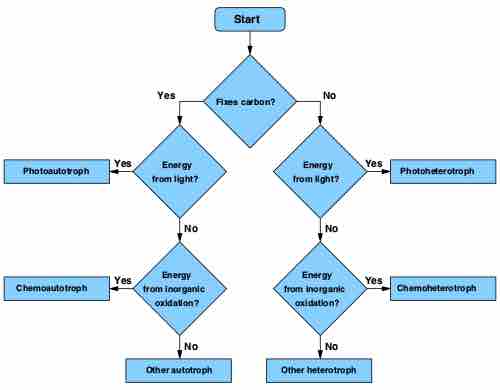Growth Terminology
The two ways that microbial organisms can be classified are as autotrophs (supply their own energy) or as heterotrophs (use the products of others) .

Metabolic characteristics of microorganisms
This is a flowchart to help determine how a microorganism undergoes growth development.
Autotrophs
An autotroph, which means self-feeding or producer, is an organism that produces complex organic compounds (such as carbohydrates, fats, and proteins) from simple substances present in its surroundings. To produce these organic compounds it either uses energy from light (by photosynthesis) or inorganic chemical reactions. Autotrophs reduce carbon dioxide (CO2) by adding hydrogen atoms to it. This reduction process forms an organic compound that stores chemical energy. Most autotrophs use water as their reducing agent (to gain hydrogen atoms), but some can use other hydrogen compounds like hydrogen sulfide. Autotrophs, and their formation of organic compounds, are an important component of the food chain because they produce the food necessary for larger, more complex organisms to grow.
Photoautotrophs
Photoautotrophs are a type of autotroph. Photoautotrophs use light (sunlight if they are green plants) as their energy source. They use this energy (physical) and convert it into chemical energy in the form of reduced carbon. This process produces energy that carries out various cellular metabolic processes.
Chemoautotrophs
Chemoautotrophs are also a type of autotroph. They derive their energy from chemical reactions and synthesize all necessary organic compounds from carbon dioxide. Most chemoautotrophs are bacteria and archaea that live in hostile environments (such as deep sea vents). Chemoautotrophs are thought to be the first organisms to inhabit earth.
Heterotrophs
A heterotroph is an organism that, unlike an autotroph, cannot fix carbon and uses organic carbon for growth. Heterotrophs use the products formed by autotrophs to survive.
Photoheterotrophs
Photoheterotrophs are a type of heterotroph. These organisms use light for energy, but cannot use carbon dioxide as their sole carbon source. They use compounds formed by autotrophs (such as carbohydrates, fatty acids, and alcohols) as their food.
Chemoheterotrophs
Chemoheterotrophs are a type of heterotroph. They are unable to fix carbon and form their own organic compounds so they must use products formed by autotrophs. These organisms use inorganic energy sources or organic energy sources to sustain life.